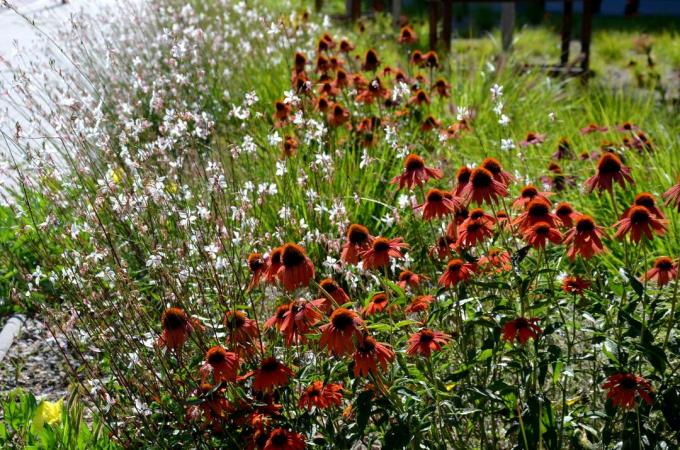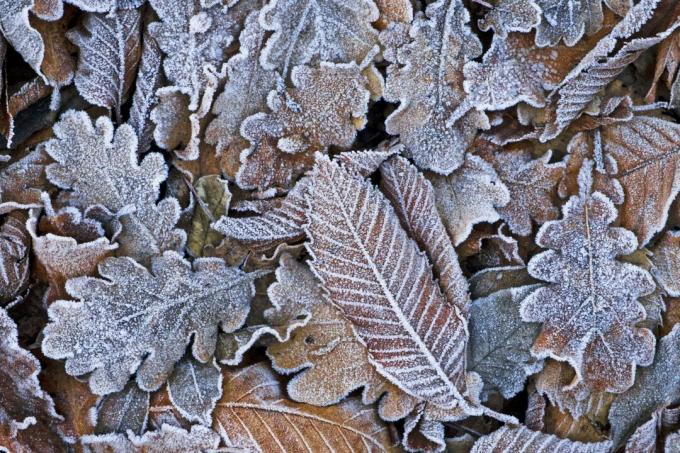The frugal candle, also called prairie candle, gives every bed a particularly delicate flair with its light, airy and filigree flowers. With an incomparable willingness to bloom, the magnificent candle enriches rock gardens, tubs and borders.

The Magnificent Candle (Gaura lindheimeri) is a perennial bloomer with countless delicate flowers reminiscent of butterflies. Find out here how to plant, cut and combine the magnificent candle, whether the Gaura is hardy and what the most beautiful varieties of the magnificent candle are.
contents
- Magnificent candle: properties and origin
- The most beautiful varieties of the magnificent candle
- Planting instructions and location of the magnificent candle
-
Cultivate Gaura lindheimeri
- Cut splendor candle
- Water and fertilize
- Is the prairie candle hardy?
- Multiply Glory Candle
- toxicity
Magnificent candle: properties and origin
The primrose belongs to the evening primrose family (Onagraceae) and originally comes from southern North America, i.e. the border region between the USA and Mexico. There it inhabits open pine forests and above all prairie landscapes, which is why it is probably also known under the name prairie candle. Its small but countless flowers reminiscent of butterflies give the magnificent candle the nickname butterfly flower. Matt blue-green, elliptically shaped leaves with slightly coarsely serrated leaf edges sit on the erect, slightly curved and only slightly branched stems of the magnificent candle. the
Gaura lindheimeri is a deciduous plant.How tall is a magnificent candle?
Depending on the variety, the floriferous perennial grows 50 to 150 cm high and forms dense clumps with a circumference of up to 90 cm.

As a permanent bloomer, the prairie candle adorns the garden with countless flowers from June until the first frost. The white to purple flowers sit like butterflies on the 30 to 60 cm long panicles. Each one flowers for only one day, shows a beautiful color gradient and ends with a capsule fruit from which the seed is taken for propagation.

Is the Magnificent Candle bee-friendly? Yes, many bees cavort around the flowers of the in summer Gaura lindheimeri. It also attracts butterflies and bumblebees.
Is the magnificent candle perennial? Yes, the magnificent candle is a perennial herb. In practice, however, it turns out to be relatively short-lived. How to get and multiply the prairie candle, we will tell below in the article.
The most beautiful varieties of the magnificent candle
There are numerous varieties of Gaura lindheimeri, which differ mainly in their color and growth height. The pink flowering variety 'Elfenbusserl' was even voted Bavarian balcony plant of the year in 2007. Below we have put together a selection of the most popular varieties of magnificent candles:
- ‘Whirling Butterflies ‘: The 'Whirling Butterflies' is probably one of the most popular varieties of the magnificent candle and not without reason: The white, large-flowered flowers of the more branching variety float like whirling butterflies above bed. It reaches a growth height of up to 70 cm.

- ‘Siskiyou Pink‘: This older and more robust variety of the Gaura lindheimeri with a growth height of 90 cm, belongs to one of the larger varieties of magnificent candles. It blooms in pink, as the name suggests, but only in late summer.

- ‘Rosy-Jane‘: This variety of magnificent candle flowers in a particularly unique way: the petals are white with pink edges. 'Rosy Jane' grows up to 70 cm.

- ‘Summer Breeze‘: It is an impressive, extra large variety, reaching up to 150 cm in height. The pink-white flowering prairie candle is particularly robust and stable and tolerates frost better than other varieties.
- ‘Short shape‘: As the name suggests, it is a low-growing variety of the magnificent candle, which is therefore particularly suitable as a container plant. The flowers of the 'Short Form' are white to pink and it grows to about 50 cm high.
- ‘Shakti‘: This variety of the magnificent candle has an intense dark pink color and is also only about 60 cm tall.
- ‘Madonna‘: It can also stand it in semi-shade, although it likes the blazing sun better. The flowering, white-flowering variety of the magnificent candle grows up to 55 cm tall.
- ‘Gambit Rose‘: Also a rather low-growing variety that convinces with its crimson flowers.
Planting instructions and location of the magnificent candle
the Gaura lindheimeri feels most comfortable in full sun. The more sun the magnificent candle gets, the more lush the flowers will be. The optimal soil for the prairie candle is sandy or rocky, poor in nutrients, well drained and dry. The magnificent candle thrives poorly on heavy and heavily humus-rich soil and falls prey to rot in autumn. This makes the plant ideal for gravel beds or the rock garden. If your garden soil is too heavy, be sure to mix in plenty of sand or fine gravel to ensure good drainage.
For successful planting in the tub, mix the potting soil with 40 to 50% coarse material, such as expanded clay or expanded clay. A sufficiently thick drainage layer made of the same material prevents waterlogging, to which the magnificent candle is particularly sensitive. The magnificent candle can easily be overwintered in a bucket without frost, which leads to stronger plants in spring.

The optimal location for the magnificent candle:
- full sun
- Poor in nutrients and humus
- Well drained and light substrate
- Not too wet
Tip: Choose a wind-protected location for the magnificent candle, because the long stems of the Gaura can otherwise easily buckle. The perfect place for the magnificent candle is in front of a south-facing house wall.

The best time to plant the young candles is from the beginning to the middle of May. After planting, no more night frosts should follow. The prairie candle is particularly effective in plantings of three to five specimens in a group. Five to seven plants fit next to each other per square meter, so the planting distance between the magnificent candles is 30 to 60 cm. In the first few weeks after planting, you should keep the magnificent candles moist until they have formed strong roots.
Tip: With bought young plants, the soil of the plant ball should be carefully removed as much as possible. This can be done, for example, by rinsing. Otherwise, the humus-rich culture substrate will hold too much water over the fall and the winter hardiness will suffer as a result.
Combine Splendor Candle: The magnificent candle loosens up every perennial border with its filigree flowers. As it tends to be one of the taller plants, choose a spot further back in the bed for it Gaura the end.

Suitable companion plants with similar site conditions as the magnificent candle are:
- lavender(Lavandula angustifolia)
- blue diamond (Perovskia atriplicifolia)
- leadwort (Plumbago auriculata)
- sedum(sedum)
- Cypress Spurge (Euphorbia cyparissias)
The magnificent candle can be combined with ornamental grasses to make it visually appealing. This includes:
- feather bristle grass (Pennisetum alopecuroides)
- blue fescue (Festuca cinerea)
- diamond grass (Calamagrostis arundinacea)
- Read more in our article ornamental grasses
The small flowers of the magnificent candle form a beautiful contrast with flowers with large flowers, for example:
- roses(Pink)
- dahlias(Dahlia)
- coneflower(Echinacea)
- globe thistles (Echinops sp.)

Gaura lindheimeri care for
The magnificent candle is a frugal plant. Cutting, watering and fertilizing are limited. If you cultivate the magnificent candle in a bucket, you should treat it to a new substrate every two years. The best time for repotting is February to March, before the Gaura sprouts again.
Cut splendor candle
The prairie candle does not need to be removed, as is the case with other perennials, as they fall off by themselves. You should only remove old panicles before seed formation if you absolutely want to avoid self-seeding of the magnificent candle. However, it is easier to pull out emerging seedlings in spring.

In late autumn is a cutting of the Gaura lindheimeri necessary to prepare them for the winter. Shorten the perennial to about 10 cm above the ground, using sharp tools. The clump cut back should then be covered with leaves to protect the magnificent candle from the cold and wet. This measure contributes enormously to a successful hibernation.
Water and fertilize
The magnificent candle is frugal in terms of water and nutrient requirements. It copes well with dry periods that are not too long. Watering is only necessary if it has not rained for a long time. If the magnificent candle grows in your tub, you should water it a little more often, because less water can be stored in the flower tub.
The fertilization of the magnificent candle is also uncomplicated: In most cases it comes Gaura without additional fertilizer. In the pot, the magnificent candle does well with a little more fertilizer. However, adding half the dosage of a liquid fertilizer indicated on the packaging to the irrigation water once a month is completely sufficient. Ours is suitable for this Plantura organic flower & balcony fertilizer particularly good. The purely organic fertilizer consists only of plant-based ingredients and is tailored to the needs of flowering plants. From the end of August until next spring, however, you should stop fertilizing.
Is the prairie candle hardy?
It is completely hardy Gaura lindheimeri Unfortunately not. At temperatures below – 10 °C and too much moisture, the root ball can be irreversibly damaged. To ensure that the prairie candle survives the winter without damage, cut the perennial back to 10 cm above the ground in autumn and cover the eyrie with plenty of brushwood and leaves. Such a rain cover protects against too much moisture. The white varieties are often more frost-resistant. Whether the site is well drained and water runs off well is crucial to the question of whether the Gaura is hardy.
A dark and cool, but frost-free room, for example the garage or shed, is suitable for overwintering the magnificent candle in the bucket. Occasionally you should give the overwintering guest a sip of water so that the root ball does not dry out completely over the winter. A careful acclimatization of the magnificent candle to bright sunlight after the winter months is recommended.

Multiply Glory Candle
Magnificent candles multiply in suitable locations by self-sowing. The capsule fruits open and drop the seeds. However, they only germinate if the soil is dry and the location is not too cold in winter.
For controlled propagation of the magnificent candle, you can harvest the seeds that have dried on the plant and sow them indoors from February. For example, a 1:1 mixture of sand and ours is suitable for sowing Plantura Organic Herb & Seed Soil, which consists of 100% natural raw materials, such as coconut fibers and quality compost. Since the Gaura is a light germinator, the seeds should not be covered with soil. After four to six weeks, the plants can be pricked out and planted in the garden after the ice saints.
Sowing outdoors is only possible from April, because the magnificent candle needs a germination temperature of at least 15 °C. If sown early, the perennial will flower in the first year, if sown outdoors it will probably only flower in the second.

Other propagation options:
- In early summer you can root 5 to 10 cm long shoots of the magnificent candle in potting soil and then plant them back in the bed.
- Propagation by dividing the clump is not recommended for the magnificent candle. If you try it anyway, you should do it in the spring with a sharp spade.
toxicity
The magnificent candle is non-toxic to humans, cats and dogs.
If you are just planning a perennial bed, then you will find our article on the Creation of a perennial bed useful tips and tricks as well as planting plans for perennial beds at different locations.



